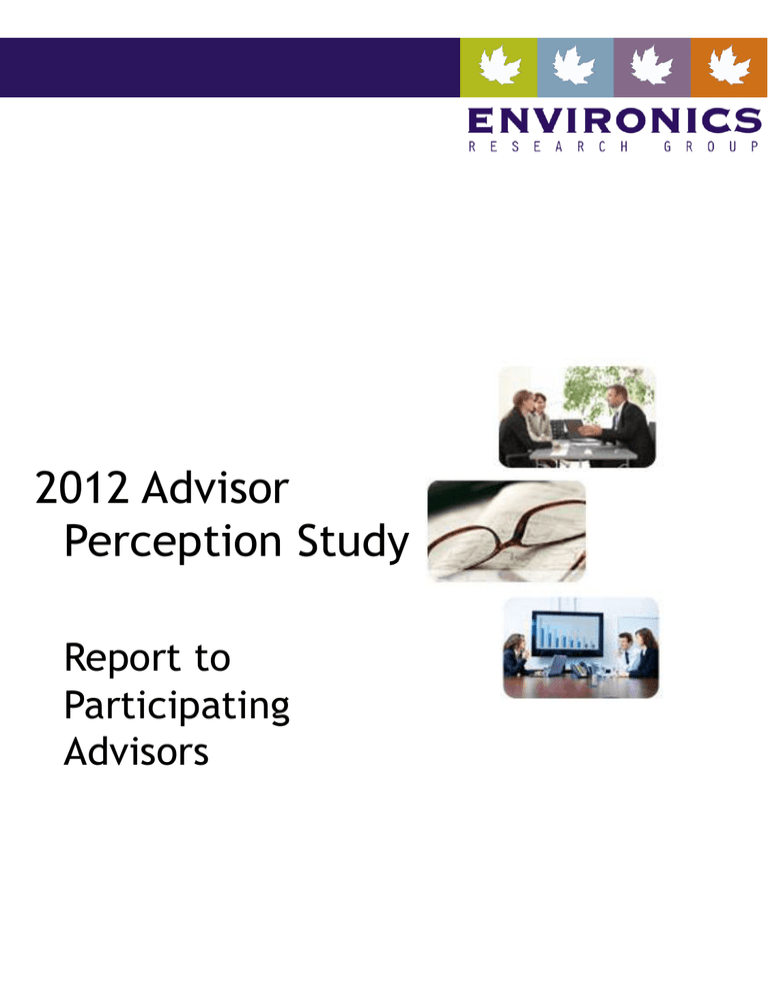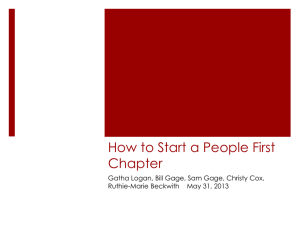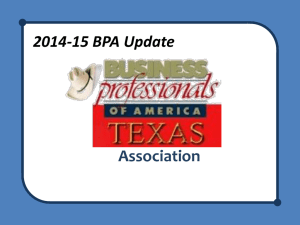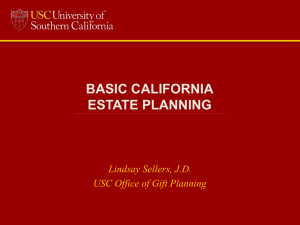What is the Advisor Perception Study?
advertisement

2012 Advisor Perception Study Report to Participating Advisors Contents What is the Advisor Perception Study? 3 Who completes the Advisor Perception Study? 4 Advisor demographics 5 Challenges facing advisors 7 The growth of fee-based compensation 9 How did the markets affect client portfolio values? 10 What types of services are advisors offering their clients? 11 Managing the product shelf 12 What influences an advisor’s decision to support a company? 13 How did the top companies perform? 14 How do advisors perceive the top companies? 17 What sources do advisors use to keep up-to-date? 19 What are the implications for 2012? 22 2 What is the Advisor Perception Study? In its 17th year, the annual Environics Advisor Perception Study is the most comprehensive tracking study of Canada’s mutual fund and insurance companies. By working co-operatively with many of Canada’s leading banks, insurance and mutual fund companies, Environics tracks the brand perceptions of the independent personal financial advisors that constitute a critical component of the Canadian financial product distribution system. Through the feedback of financial advisors from across Canada, Environics provides the industry with vital information about how their companies are perceived in terms of product performance, relationship-building, sales and marketing team effectiveness, and overall business operations. The depth of information that Environics collects allows companies to identify areas where they can improve or enhance their performance in the eyes of their key clients – Canada’s personal financial advisors. HOW IS THE STUDY CONDUCTED? The Advisor Perception Study has an insurance component and a mutual fund component, both with separate questionnaires. In 2012, a total of 2,411 advisors participated in the study, with 1,990 advisors completing the mutual fund questionnaire and 1,855 advisors completing the insurance questionnaire. Of those advisors who completed the mutual fund questionnaire, 663 have been identified as top-performing advisors, with greater than $15 million in mutual fund assets under management. Data were collected between May and July 2012 via an online web survey that was emailed to a database of approximately 35,000 financial advisors, which includes many who are in Environics’ own Advisor Perception Panel. 3 Who completes the Advisor Perception Study? Respondents to the Advisor Perception Study represent three distinct service delivery channels. In 2012, 31 percent of the sample are identified as IIROC-licensed (belonging to IIROC member firms), 40 percent of the respondents as MFDAlicensed (belonging to MFDA member firms that are not IIROC member firms) and 29 percent of respondents identify as Managing General Agents (those whose core business is insurance but some of whom are licensed to sell mutual funds). These numbers are similar to last year’s results. The Advisor Perception Study questionnaire is divided into two components. Most advisors complete both the mutual fund and insurance questionnaire; those who are not licensed to sell one or the other only answer the relevant components. Three-quarters (74%) of financial advisors in the sample report that they have been providing advice for 10 or more years, with more than half (54%) reporting that they have been providing advice for 15 years or more. Ten percent are newer to the profession, having provided advice for less than five years. Advisor type 31% 28% IIROClicensed 2012 2011 40% 37% MFDAlicensed 29% 34% MGA/GA Years providing advice 54% 15+ years 54% 20% 10 to 14 years 21% 2011 16% 5 to 9 years Less than 5 years 2012 16% 10% 9% 4 Advisor demographics REGIONAL DISTRIBUTION. Each year, the Advisor Perception Study captures a diverse sample of advisors from across Canada. This year, the distribution of advisors across different regions of Canada remained relatively consistent with our findings in 2011. Almost one-fifth of advisors (17%) are conducting business in parts of Ontario outside the Greater Toronto Area (GTA), while almost a quarter (23%) are conducting business within the GTA. Meanwhile, 17 percent of advisors are conducting business in British Columbia, 11 percent in Alberta and seven percent in the Prairies (Manitoba and Saskatchewan). A further two in ten (18%) are respondents from Quebec, while six percent of advisors do business in the Atlantic region. GENDER DISTRIBUTION. In 2012, there is more than a 4:1 male to female ratio among advisors, which is comparable to our findings in previous years. Furthermore, for top-performing advisors, the percentage of female advisors saw a slight decline from 13 to 11 percent. The highest incidence of female advisors exists in British Columbia (19%), the GTA (19%) and the Prairies (19%), where one in five respondents are women. There is a lower incidence of female advisors in Quebec (15%). Region 17% 16% BC 11% 10% AB 7% 7% MB/SK 23% 22% GTA 17% 17% Outside GTA 18% PQ 2012 6% 6% Atlantic All advisors 22% 2011 Top performers 2012 2011 2012 2011 Male 82 83 89 87 Female 17 17 11 13 Top Performers includes those advisors with at least $15M in mutual fund AUM 5 STAGE OF BUSINESS. In 2012, about seven in ten (71%) full-time advisors were over the age of 40. Similarly, we see that, on average, advisors have been providing advice for 16.2 years, a similar proportion to 2011. Most advisors believe that their business has room to grow, with more than half (52%) reporting that they are in a growth phase, while a further nine percent of respondents report that their businesses are in the start-up phase. While many are planning for growth, the number of businesses in the succession planning phase has remained stable at seven percent (as in 2011), but is an increase from five percent in 2009. Stage of business Start-up 9% 7% 52% Growth 55% 30% Maturity 30% Succession Planning 7% 2012 7% 2011 6 Challenges facing advisors This year we asked advisors about the challenges they face in the financial services industry: PERFORMANCE: For many advisors, market performance is the most important issue facing the industry. This includes concerns about volatility and poor returns on client investments, as well as uncertainty in the financial markets and the economy generally. COMPLIANCE: Advisors find compliance requirements in the financial services industry onerous and ineffectual. They are frustrated that time spent on compliance robs them of time they feel could be better spent building their businesses and seeing clients. PRACTICE ISSUES: Advisors face myriad issues in running their practices. Challenges include prospecting and succession planning , the quality of service they receive from mutual fund and insurance companies, and their desire to provide good financial planning services to their clients. Industry Issues – Coded Verbatims Performance 30% Compliance 27% Practice Issues 17% Fees and costs 9% Perceptions of industry 9% Clients 7% Competition 7% Products 3% Other 2% None 1% FEES AND COSTS: Cost competition is an issue for many advisors. They feel pressure on both their revenues and their costs. Many advisors are frustrated about the compensation they receive from mutual fund and insurance companies as well as high product costs (MERs and insurance premiums). 7 Challenges facing advisors PERCEPTIONS OF THE INDUSTRY: Many advisors relate that financial institutions, the financial services industry and the markets themselves have lost credibility in the eyes of investors. This includes negative perceptions generated by the media concerning investment scandals and dishonest financial advisors. CLIENTS: Managing client expectations around market performance is an issue for a number of advisors. Many are also frustrated by client attitudes towards savings and debt and their lack of preparation for retirement. COMPETITION: Advisors face competition from a number of channels. Competition from banks is especially of concern, as well as that from other advisors and DIY (do-ityourself) investing. PRODUCTS: Advisors can be frustrated by the quality or lack of availability of products, as well as excessive product proliferation. 8 Growth of fee-based compensation One of the clearest trends in the Advisor Perception Study over the past several years has been the growth in fee-based compensation. About a third (30%) of advisors across the industry received some level of fee-based compensation. However, this differs significantly by advisor type. Seven in ten (70%) of IIROC-licensed advisors receive fee-based compensation, while this is only the case for 15 percent of MFDA-licensed advisors and ten percent of MGA advisors. For IIROC-licensed advisors, this is a significant increase from 2009, when only 58 percent received fee-based compensation. Proportion of advisors receiving compensation type 91% 92% Commission-based 30% 29% Fee-based 22% 22% Bonus 16% 13% Salary Among those who receive some fee-based compensation, it accounts for 43% of their income. The average is higher for IIROClicensed advisors (47%) than for MFDAlicensed advisors (37%) or MGAs (20%). 3% 3% Other All Advisors IIROC MFDA MGA 2012 2012 2012 2012 Commission-based 91 94 83 97 Fee-based 30 70 15 10 Bonus 22 22 15 32 Salary 16 13 23 12 Other 3 3 2 3 9 How did the markets affect client portfolio values? The value of advisors’ books continues to hold strong after the significant losses of 2009. This is with the exception of MGA/GAs, who have seen a decline in AUM from 2010. While the global recession had an impact on the portfolios of many investors in 2009, it generally did not significantly alter the distribution of client portfolio values within the average advisor’s book. This is again true of the economic recovery, as we see little change in the 2012 proportions of clients by portfolio value. Slightly less than a quarter of client portfolios fall in each of the less than $50,000, $50,000 to $99,999, and $100,000 to $249,999 categories (22%, 21% and 23%, respectively), while the remaining 33 percent of portfolios are valued at over $250,000. Average assets under management (in millions $) 2012 2011 2010 IIROClicensed 70.6 71.2 67.6 MFDAlicensed 20.0 20.8 21.4 MGA/ GA 11.2 12.3 16.8 Mean proportion of clients with a portfolio value of: Less than $50K 22% 22% $50K to $100K 21% 22% 23% 23% $100K to $250K In 2012, about half of advisors (49%) report having at least one million-dollar client. However, among the top-performing advisors (those with at least $15M in mutual fund AUM), about eight in ten report at least one million-dollar client (81%). Other research by Environics shows that only a quarter of Canadian households have financial assets of $100,000 or more, and only 14 percent have assets of $250,000 or more. 18% 18% $250K to $500K 10% 10% $500K to $1M $1M + 5% 5% 2012 2011 10 What types of services are advisors offering their clients? Advisors did not report any significant changes in the provision of planning services between 2012 and 2011. While nine in ten (86%) advisors offer their clients annual reviews of their financial plans, only about six in ten (58%) clients actually receive this service. Furthermore, roughly two-thirds of advisors offer services like succession planning (66%), formal written plans (63%) and tax advice (64%), but only small proportions of clients actually receive these services (30%, 36% and 45%, respectively). This suggests that, while advisors may offer services such as succession/estate planning, tax advice and formal written financial plans, they remain selective about which clients these services are offered to and the highest service levels are likely reserved for those clients with the highest portfolio values. Incidence of planning services offered to clients Annual financial plan review Average proportion of clients receiving services 86% 89% Succession or estate planning 66% 67% 2012 2011 58% 57% 30% 30% Formal written plan 63% 64% 36% 34% Tax advice (not tax returns) 64% 65% 45% 43% 35% 33% 46% 47% Lifestyle planning 2012 2011 11 Managing the product shelf Advisors give careful consideration to the fund companies they include in their product shelf. They must balance the benefit of providing clients a good selection of mutual funds with the costs and risks of researching and adding new funds to their offering. For several years, our research has shown that many advisors are seeking to reduce the number of fund companies on their shelves in order to streamline their businesses, and minimize regulatory and administrative burdens. The strength of the relationship between sales penetration and volume becomes clear when looking at the average percentage of sales by rank. In 2012, the mutual fund company sold most by an advisor accounted for an average of 50 percent of the advisor’s total sales. By comparison, the company sold secondmost accounted for only an average of 22 percent of the advisor’s total sales, and the fall from there is precipitous. Because advisors prefer to sell a limited number of funds, top ranking is heavily rewarded. In other words – if you’re not at the top, you’re not in the game. This is true also of the insurance side, where the most-sold in life premiums accounted for 68 percent of sales in 2012, while second-most accounted for 20 percent. It is critical that fund companies build loyalty among advisors in order to win top supporter status. In 2012, advisors who sell mutual funds reported selling an average of 5.1 fund companies. It is interesting to note that while advisors project reducing their product shelf in 2013, they did not actually do so in 2012, contrary to their 2011 prediction which suggested they would be shortening their product shelf in the coming year. All advisors Mean number of fund companies supported IIROClicensed MFDAlicensed MGA/GA 2012 2011 2012 2011 2012 2011 2012 2011 5.1 5.0 5.3 5.3 5.3 5.2 3.8 4.3 12 What influences an advisor’s decision to support a company? In the Advisor Perception Study, advisors are asked to rate mutual fund and insurance companies across 24 common dimensions. Additionally, advisors are asked to rate the importance of each dimension, allowing us to compare how well the industry is performing on the dimensions that matter most to advisors. Advisors report that a combination of performance and back office-related criteria drive their support. Specifically, advisors feel it is very important that a fund company have high quality fund managers who can deliver consistent performance, as well as a competent back office staff that can lower the incidence of transaction problems and quickly resolve them when they arise. While Appropriate MERs is in the middle of the pack for importance, it jumped from 7.3 to 7.7, the largest movement of any of our dimensions. This is especially noticeable among IIROC-licensed advisors, and suggests that fee-conscious clients will cause advisors to be more selective on the basis of MERs. In 2012, 51 percent of advisors greatly increased their business with a fund company. One-third (34%) of advisors say that this increase was related to overall fund performance. A quarter (26%) say they increased business because they of wholesaler quality and support, while 15 percent cite the quality of fund managers. Customer service (8%) and access to specific products (6%) are also mentioned. Five most important factors for advisors (mean rating out of 10) Quality of fund managers 8.9 Product performance 8.9 Corrects problems quickly 8.7 Consistent performance 8.7 Product offering matches client needs 8.5 Top reasons for increasing business with mutual fund companies Fund performance 34% Wholesaler quality/support 26% Fund managers Customer service Access to specific products 15% 8% 6% 13 How did the top companies perform? MUTUAL FUND COMPANIES. Fidelity and Dynamic Mutual Funds lead the industry in terms of sales penetration. However, while industry leader Fidelity maintained penetration, Dynamic lost ground, with half (50%) of advisors now indicating that they had sold Dynamic funds in the past 12 months, down from 53 percent in 2011. In third place (47%), CI continues to lose ground, falling from 2009 (53%) levels. 2012 saw the emergence of two new trends – the growing penetration of newer and smaller firms such as Sentry Investments and Russell Investments, and the strengthening of the bank-based fund companies. This has occurred at the same time as a contraction in the penetration of the larger, traditional independent fund companies. The smaller firms that are popular with advisors are those which provide niche products to clients and have delivered exceptional performance in recent years. At the other end of the spectrum, the big banks, having survived the financial crisis so impressively, are attracting clients with their reputation for stability and integrity. We expect these trends to continue into the future, and to significantly impact the landscape of the financial services industry in Canada. Top 10 mutual fund companies by sales penetration 57% 58% Fidelity Investment 50% 53% Dynamic Mutual Funds 47% 48% CI Investments 42% 45% Mackenzie Investments 34% 39% AGF Funds 34% 34% TD Mutual Funds 31% 30% Invesco Trimark Franklin Templeton IA Clarington Manulife Mutual Funds 25% 26% 22% 20% 22% 21% 2012 2011 14 ETF COMPANIES. Exchange traded funds (ETFs) are a fast-growing investment segment. In 2012, 43 percent of IIROC-licensed advisors report selling ETFs, an increase from 39 percent in 2009. Favoured especially by those seeking to match an index, ETFs are increasingly finding a place in client portfolios, whether for core or niche exposure. Top 5 ETF companies among advisors selling ETFs iShares 76% Claymore iShares by BlackRock leads the market among those IIROC-licensed advisors selling ETFs. Three-quarters (76%) of advisors offer iShares to their clients. At a fairly distant second, Claymore (also owned by BlackRock) is offered by half (48%) of the advisors. BMO (44%), and Horizons (26%) are also mentioed. Invesco PowerShares have a considerable presence as well (21%), and are credited for helping to reinvigorate the Invesco Trimark brand. 48% BMO Horizons Invesco PowerShares 44% 26% 21% 15 INSURANCE COMPANIES. On the insurance side, Manulife maintained its position as market lead in 2012, with 60 percent of advisors reporting that they sold Manulife insurance products in the past 12 months. Top 10 insurance companies by life premium sales penetration 60% 59% Manulife 38% 41% Canada Life 2012 saw a decline among some companies in the industry. Canada Life lost ground (38%, down from 41% in 2011), as did Empire Life (31% in 2012, down from 34% in 2011. The past year also saw changes in penetration in line with the general trend of the growth of bank based insurance firms. RBC Insurance was sold by a quarter of advisors (26%, up from 24% in 2011), and with the recent acquisition BMO/AIG jumped from 13 percent to 24 percent penetration. 31% 34% Empire Life 27% 27% Transamerica Life RBC Insurance 26% 24% Industrial-Alliance 26% 24% BMO/AIG 24% 13% 20% 19% Equitable Life Sun Life Desjardins 12% 12% 2012 2011 10% 9% 16 How do advisors perceive the top companies? MUTUAL FUND COMPANIES. Correlating with Fidelity’s top score in sales penetration in 2012, advisors once again gave Fidelity the highest overall company rating in this year’s Advisor Perception Study (6.9 out of 10, close to 7.0 in 2011). New to the study in 2012, Sentry Investment achieves an impressive second place ranking based on its score of 6.4. While in 2012 Sentry only has 15 percent sales penetration, this very high rating bodes well for it’s future, and suggests greater penetration in the coming year. Russell Investments, another smaller firm, also scores very well (6.2, up from 5.9 in 2011). The notable turn-around story for 2012 is the success of Invesco Trimark increasing from 4.7 in 2011 to 5.4 this year. Gains of this magnitude may result in increased sales penetration for 2013. Gaining as well is NEI Investments (5.0 to 5.4). Overall company rating (mean score out of 10) 6.9 7.0 Fidelity Investments 6.4 Sentry Investments 6.3 6.9 Dynamic Mutual Funds Russell Investments 6.2 5.9 TD Mutual Funds 6.1 6.2 CI Investments 6.0 6.0 IA Clarington 6.0 5.8 Standard Life 5.9 5.7 Mackenzie Investments 5.8 5.9 RBC Mutual Funds 5.7 5.7 National Bank 5.6 5.7 Manulife Mutual Funds 5.5 5.6 NEI Investments 5.4 5.0 Invesco Trimark 5.4 4.7 Franklin Templeton 5.3 5.3 BMO Guardian Funds 5.2 5.0 CIBC Renaissance 4.9 4.7 2012 AGF Funds 4.3 4.9 2011 17 INSURANCE COMPANIES. Manulife maintained a strong lead in overall company ratings, at 6.8 out of 10 (down from 6.9 in 2011, 7.0 in 2010, and 7.2 in 2009). Standard Life earned a second-place ranking, based on strong ratings in their seg. fund division. Great West Life, Canada Life, and Sun Life filled out the top 5. Several companies slipped in terms of their ratings this year. Empire Life (6.2, down from 6.5 in 2011) and RBC Insurance (5.6, down from 5.9 in 2011) both saw decreases. This may translate into lower sales penetration in the coming year. Overall company rating (mean score out of 10) 6.8 6.9 Manulife Standard Life 6.7 6.6 Great West Life 6.6 6.6 Canada Life 6.4 6.5 Sun Life 6.3 6.5 MEAN 6.2 6.4 Empire Life 6.2 6.5 Desjardins 6.2 6.2 Industrial Alliance 6.0 6.1 Equitable Life 6.0 6.2 Transamerica Life 5.9 5.8 RBC Insurance 5.6 5.9 BMO/AIG 5.5 5.6 2012 2011 18 What sources do advisors use to keep up-to-date about products, companies or trends in the industry? When asked what sources they rely on to keep up-to-date about products, companies or trends in the industry, it is clear that advisors are using a relatively wide variety of sources. These include sources that are geared specifically towards advisors, as well as broader sources that are also oriented towards consumer investors and the general investment community. PRINT MEDIA. Despite the range of sources, several stand out as being utilized by advisors more extensively. These top mentions for print media include the Globe and Mail, Advisor’s Edge, Investment Executive and the National Post. In Quebec, Le Devoir is relied upon heavily by advisors. Print media Sources somewhat or heavily relied on by advisors Net Use: Globe & Mail/ Report on Business 21% 32% 53% Advisor’s Edge/ Advisor’s Edge Report 10% 39% 49% Investment Executive 10% 39% 49% National Post/ Financial Post 9% 23% 32% Investors’ 2% 12% Digest 14% New York Times 1% 8% Le Devoir 4% Additional mentions: • Advocis Forum • Barron’s • Bloomberg • The Economist • La Presse • Les Affaires • Wall Street Journal • Mutual fund companies • Own Firm 9% Heavily 5%/ 12% in Que. Somewhat 19 ONLINE MEDIA. It is clear that advisors are relying heavily on online resources in their efforts to keep up-to-date on the industry, and they identify a wide variety of online sources. Between online, print and television sources, advisors are more likely to rely heavily on online sources for information and are also more likely to select online sources overall. Furthermore, many are taking advantage of the online offerings of many of their favourite print media sources. Top mentions for online media include: •Globeandmail.com/Globeadvisor.ca •Morningstar.ca •Advisor.ca •Bloomberg.com •Investmentexecutive.com •Nationalpost.com In Quebec, ledevoir.com is also relied upon heavily by advisors. Online media Sources somewhat or heavily relied on by advisors Net Use: globeandmail.com/ globeinvestor.com 22% globeadvisor.ca 18% morningstar.ca 14% advisor.ca 13% bloomberg.com 10% investmentexecutive.com 10% nationalpost.com/ financialpost.com 33% 6% 34% 31% 38% 22% 31% 21% 45% 51% 41% 28% 13% 7% ledevoir.com 3% 52% Additional mentions: • CNBC.com • Google Finance • Reuters.com • Seekingalpha.com • Yahoo.com/Finance • Marketwatch.ca • Retirehappy.ca • Zerohedge 32% advisoranalyst.com 2% 10% fundlibrary.com 55% 9% Heavily Somewhat 4% / 10% in Que. 20 TELEVISION MEDIA. In contrast to online and print media, advisors rely on television much less to keep them informed on products, companies and trends in the industry. Top mentions for television include Business Network News and CNN Money, with half of advisors relying heavily (15%) or somewhat (28%) on Business Network News. Television media Sources somewhat or heavily relied on by advisors Net Use: Business Network News (BNN) CNN Money 16% 5% 30% 27% 22% Heavily 46% Somewhat Additional mentions: • BBC Business Report • Bloomberg TV • Canal Argent • CBC/Newsworld • CNBC • MSNBC 21 Implications for 2013 The financial industry is going through a period of tremendous change. The evolution of financial institutions, financial products, and advisor compensation will fundamentally change the landscape of the industry going forward. The 2012 Advisor Perception Study saw increased penetration and incremental ratings gains for bank-based fund companies, as well as for smaller, niche fund companies. Having weathered the financial crisis, the banks have earned a reputation for stability and their lower MERs speak to advisors’ growing sensitivity to cost this year. However, traditional independent fund companies retain a solid base of strength and will not give up market share readily. This year saw the introduction of a new fund company – Sentry Investments - to our list of fund companies. Sentry has seen considerable growth on the basis of strong fund performance and back-to-back Lipper awards. Their continued growth will depend on their ability to continue to deliver the outperformance advisors now expect from them. In addition to Sentry, advisors are making greater use products from smaller fund companies to round out and tailor their clients’ portfolios. The growth of fee-based compensation continued in 2012. Increasingly, advisors are turning to fee-based options. Thanks in large part to the media attention on the topic, clients are concerned the size of commission payments as well as the potential for biased advice. The focus on commissions and fees will likely continue, as some in government and industry continue to push for greater regulatory restrictions on advisor compensation. Financial advisors will face a number of challenges in the coming year. Advisors tell us that they are most concerned about market performance as the economy and financial markets continue to seek stability and growth. Advisors concerns about MERs have jumped sharply this year as clients continue to apply pressure on costs. This is also reflected in the growing popularity of ETFs, which are perceived as providing a lower-cost alternative to traditional mutual funds. These prominent concerns about fees from both advisors and clients should persist in the coming year, especially should market returns continue to stagnate. For more information, contact: About this report David MacDonald, MBA, CMRP Group VP, Financial Services Division Environics Research Group 33 Bloor Street East, Suite 900 Toronto, Ontario M4W 3H1 Tel: 416•920•9010 e: david.macdonald@environics.ca This report is prepared exclusively for the advisors who have shared their views in the 2012 Advisor Perception Study and must not be circulated without permission from Environics Research Group. 22








